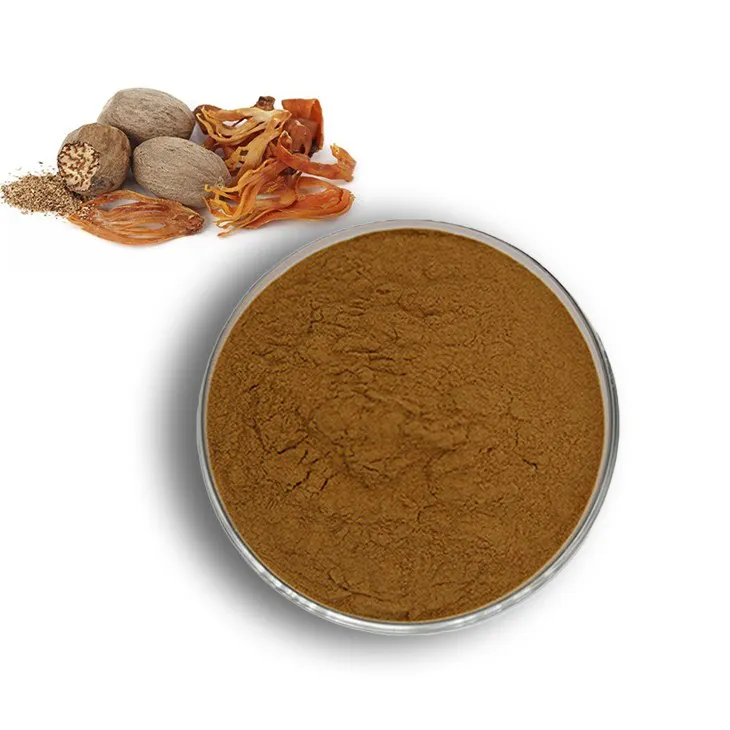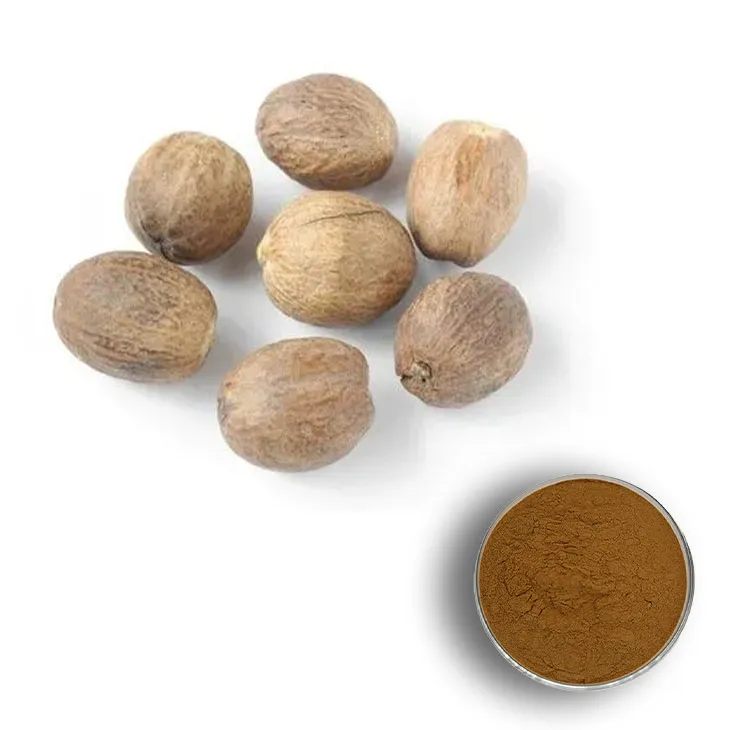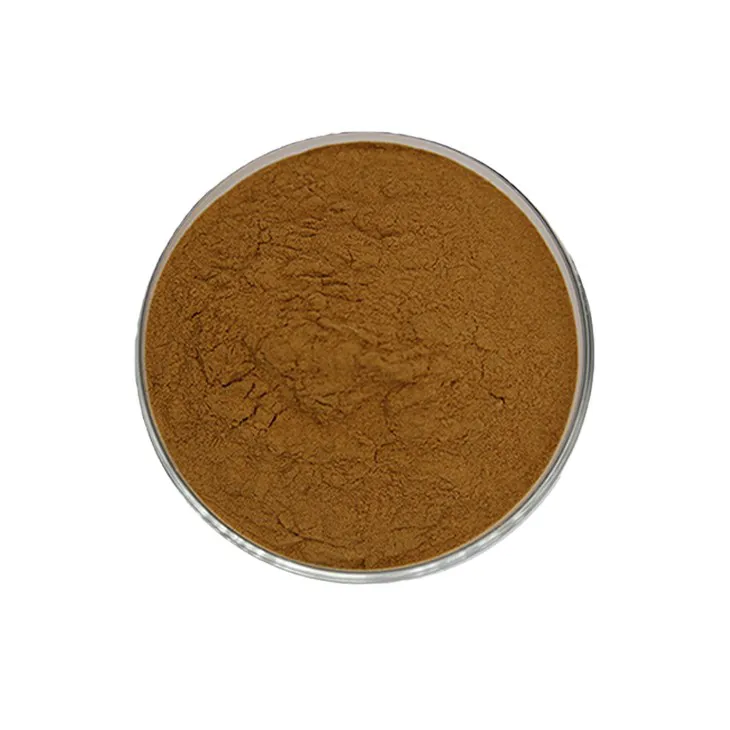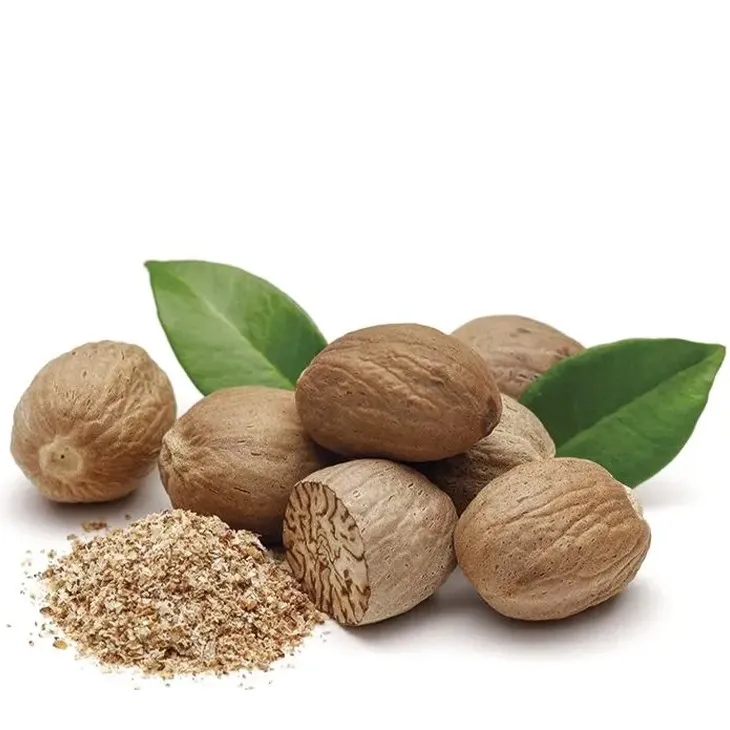- 0086-571-85302990
- sales@greenskybio.com
Nutmeg extract: China vs. the United States.
2024-11-27

1. Introduction
Nutmeg, a spice with a warm, spicy aroma, has been used for centuries in cooking, traditional medicine, and perfumery. Nutmeg Extract, which contains the concentrated flavors and potentially beneficial compounds of nutmeg, has gained increasing attention in both China and the United States. This article aims to explore the differences and similarities in Nutmeg Extract production, quality control, research, and consumer usage in these two major regions, as well as analyze the impact of agricultural practices, scientific research, and trade policies on Nutmeg Extract.

2. Production of Nutmeg Extract
2.1 China
In China, nutmeg production is relatively limited compared to some other countries. However, China has a growing interest in nutmeg extract production. China mainly imports raw nutmeg from countries with larger nutmeg plantations, such as Indonesia and Grenada. Once imported, Chinese producers use modern extraction techniques to obtain nutmeg extract. These techniques often involve solvent extraction or supercritical fluid extraction. Solvent extraction is a common method, where solvents like ethanol are used to dissolve the active compounds from nutmeg. Supercritical fluid extraction, on the other hand, uses substances like carbon dioxide in a supercritical state, which offers advantages such as better selectivity and leaving no solvent residues.
2.2 United States
The United States also imports a significant amount of nutmeg for extract production. Some nutmeg is grown in small - scale plantations in Hawaii, but it is not sufficient to meet the domestic demand. American producers focus on high - quality extract production. They often use advanced extraction technologies similar to those in China, but with a stronger emphasis on compliance with strict regulatory requirements. For example, in the United States, the extraction facilities need to meet the standards set by the Food and Drug Administration (FDA). This includes strict control over the purity of solvents, extraction conditions, and the final product quality.

3. Quality Control
3.1 China
China has a comprehensive quality control system for nutmeg extract. At the import stage, the customs authorities check the quality of raw nutmeg to ensure that it meets the national standards. These standards cover aspects such as pesticide residues, heavy metal content, and microbial contamination. Once in the production process, manufacturers follow Good Manufacturing Practice (GMP) guidelines. They conduct regular quality tests on the extract, including tests for the main active ingredients, such as myristicin and elemicin. In addition, Chinese quality control also focuses on the stability of the extract during storage and transportation, to ensure that the product maintains its quality until it reaches the consumers.
3.2 United States
In the United States, quality control for nutmeg extract is extremely stringent. The FDA sets detailed regulations for the production, labeling, and marketing of nutmeg extract. Manufacturers are required to conduct extensive safety and quality tests. For example, they need to prove that the extract is free from harmful contaminants and that the levels of active ingredients are within the safe and effective range. Labeling requirements are also very specific, with clear information about the source of nutmeg, extraction method, and any potential allergens. This helps consumers make informed decisions and ensures the safety of the products on the market.

4. Research on Nutmeg Extract
4.1 China
Chinese research on nutmeg extract has been growing steadily in recent years. Chinese researchers are interested in exploring the traditional medicinal properties of nutmeg extract. They are conducting studies on the anti - inflammatory, antioxidant, and antimicrobial activities of nutmeg extract. For example, some research has found that certain compounds in nutmeg extract can inhibit the growth of bacteria and fungi. Additionally, Chinese researchers are also looking into the potential applications of nutmeg extract in the food and cosmetic industries. They are studying how to use nutmeg extract to enhance the flavor of food products and improve the skin - care effects of cosmetics.
4.2 United States
In the United States, research on nutmeg extract is more focused on its safety and potential interactions with drugs. Given the increasing use of nutmeg extract in dietary supplements, American researchers are concerned about its potential side effects. They are conducting studies to determine the safe dosage range of nutmeg extract and to investigate whether it can interact with other medications. For example, some studies have shown that high doses of nutmeg extract may cause adverse reactions such as nausea, vomiting, and hallucinations. American research also aims to develop more accurate and reliable methods for analyzing the composition of nutmeg extract.

5. Consumer Usage
5.1 China
In China, nutmeg extract is mainly used in the food and traditional medicine industries. In the food industry, it is used as a flavoring agent in baked goods, meat products, and beverages. In traditional Chinese medicine, nutmeg extract is believed to have the functions of warming the spleen and stomach, and relieving diarrhea. It is often used in the formulation of some traditional Chinese medicine prescriptions. However, consumer awareness of nutmeg extract is still relatively limited compared to more common spices. Only a small portion of consumers are familiar with its specific functions and uses.
5.2 United States
In the United States, nutmeg extract is widely used in the food, dietary supplement, and cosmetic industries. In the food industry, it is used in a variety of products, such as pies, puddings, and seasonings. In the dietary supplement market, nutmeg extract is promoted for its potential health benefits, such as digestive support and stress relief. In the cosmetic industry, it is used in some skin - care products for its antioxidant properties. American consumers are generally more aware of nutmeg extract due to extensive marketing and education efforts in the dietary supplement and cosmetic industries.
6. Impact of Agricultural Practices
6.1 China
Since China imports a large amount of raw nutmeg, the agricultural practices in nutmeg - producing countries have an impact on China's nutmeg extract production. For example, if there are changes in the use of pesticides or fertilizers in the exporting countries, it may affect the quality of imported nutmeg. China is also exploring the possibility of promoting sustainable agricultural practices in nutmeg - producing countries through cooperation and investment. This can help ensure a stable supply of high - quality nutmeg for extract production. In addition, China is gradually strengthening its own research on nutmeg cultivation techniques, in case of potential supply disruptions in the future.
6.2 United States
In the United States, the small - scale nutmeg cultivation in Hawaii is influenced by local agricultural policies. These policies focus on promoting sustainable farming methods, such as organic farming and water conservation. The quality of nutmeg produced in Hawaii is affected by these practices. For imported nutmeg, the United States also encourages its trading partners to adopt sustainable agricultural practices through trade agreements and cooperation. This is important for ensuring the quality and safety of nutmeg used for extract production, as well as for environmental protection.
7. Impact of Scientific Research
7.1 China
Chinese scientific research on nutmeg extract is promoting the development of the industry. The findings on the medicinal and functional properties of nutmeg extract are inspiring new product development in the food and medicine industries. For example, based on the research results of the antioxidant activity of nutmeg extract, some food companies are considering developing new functional foods. Moreover, research on extraction techniques is also helping Chinese producers to improve production efficiency and product quality, which can enhance the competitiveness of Chinese - produced nutmeg extract in the international market.
7.2 United States
American scientific research on nutmeg extract has a significant impact on regulatory policies and consumer awareness. The research on the safety and potential side effects of nutmeg extract has led to more strict regulations on its use in dietary supplements. This ensures the safety of consumers who use these products. At the same time, the research findings are also widely disseminated to consumers, increasing their understanding of the potential risks and benefits of nutmeg extract. This can influence consumer choices and promote the healthy development of the nutmeg extract market in the United States.
8. Impact of Trade Policies
8.1 China
China's trade policies play an important role in nutmeg extract production. Tariffs and trade agreements affect the cost of importing raw nutmeg. For example, free - trade agreements with nutmeg - producing countries can reduce the cost of imports, which can in turn affect the price of nutmeg extract in the domestic market. China also has trade policies to encourage the import of high - quality nutmeg and to promote the export of processed nutmeg extract products. These policies help China to integrate into the global nutmeg extract industry and enhance its influence in the international market.
8.2 United States
In the United States, trade policies also have a major impact on nutmeg extract. Tariffs on imported nutmeg can influence the cost of production for domestic extract producers. In addition, trade regulations related to food safety and quality ensure that imported nutmeg and nutmeg extract meet the high standards of the United States. The United States also uses trade policies to protect domestic producers from unfair competition, while at the same time promoting international cooperation in the nutmeg extract industry to ensure a stable supply of high - quality products.
9. Conclusion
In conclusion, there are both differences and similarities in nutmeg extract production, quality control, research, and consumer usage between China and the United States. China and the United States both rely on imports to a large extent for nutmeg extract production, but they have their own characteristics in terms of production techniques, quality control, research focus, and consumer applications. Agricultural practices, scientific research, and trade policies in both regions have a significant impact on the development of the nutmeg extract industry. By understanding these differences and similarities, and the impact of various factors, both countries can further promote the healthy development of the nutmeg extract industry, improve product quality, and better meet the needs of consumers.
FAQ:
1. What are the main agricultural practices for nutmeg production in China and the United States?
In the United States, nutmeg cultivation might be limited due to its climate in most areas, and it may rely on specific regions with suitable micro - climates. However, in general, modern irrigation systems, pest control measures using advanced pesticides and biological control methods are likely employed when nutmeg is grown on a small scale. In China, for nutmeg which is mainly grown in some southern regions, traditional agricultural practices like terracing in hilly areas are used. Organic fertilizers are often applied, and farmers also make use of natural enemies for pest control. Additionally, China has been promoting the use of modern agricultural technologies such as precision irrigation and greenhouse cultivation in some nutmeg - growing areas to improve yields and quality.
2. How does quality control of nutmeg extract differ between China and the United States?
In the United States, quality control of nutmeg extract is mainly regulated by strict federal and state laws. The Food and Drug Administration (FDA) sets standards for contaminants, purity, and labeling. High - tech analytical instruments like gas chromatography - mass spectrometry (GC - MS) are commonly used to detect and quantify the components in nutmeg extract and ensure its safety and quality. In China, there are also national and local quality standards. Chinese regulatory authorities conduct regular inspections of nutmeg extract production facilities. In addition to advanced testing methods similar to those in the US, traditional Chinese medicine - based quality evaluation methods may also be incorporated, considering the potential use of nutmeg in traditional Chinese medicine. For example, sensory evaluation by experienced professionals may be part of the quality control process.
3. What are the major research focuses on nutmeg extract in China and the United States?
In the United States, research on nutmeg extract often focuses on its potential applications in the food and pharmaceutical industries. Scientists study its chemical composition to develop new food flavors and preservatives. In the pharmaceutical area, research is directed towards understanding its pharmacological properties, such as anti - inflammatory and antioxidant effects, and exploring its potential in drug development. In China, in addition to similar research in the food and pharmaceutical sectors, there is also a focus on exploring the compatibility of nutmeg extract with other traditional Chinese medicine ingredients. Chinese researchers may study how nutmeg extract can enhance the efficacy of traditional Chinese medicine formulas for treating certain diseases, such as digestive disorders.
4. How do consumer usages of nutmeg extract vary in China and the United States?
In the United States, nutmeg extract is commonly used in the food industry, especially in baking products like cakes, cookies, and pies to add flavor. It is also used in some perfumes and cosmetics. In the pharmaceutical area, it may be used in over - the - counter products for minor digestive problems. In China, while it is also used in the food industry for flavoring in some traditional and modern foods, it has a long - standing use in traditional Chinese medicine. It may be used in decoctions or prescriptions to treat conditions such as abdominal pain, diarrhea, and nausea. Some consumers may also use it in home - made health - promoting tonics.
5. What is the impact of trade policies on the nutmeg extract trade between China and the United States?
Trade policies play a significant role. In the United States, import tariffs and regulations on food safety and quality can affect the import of nutmeg extract from China. For example, if the US imposes higher tariffs on Chinese nutmeg extract products, it can increase the cost of these products in the US market, thus affecting their competitiveness. In China, trade policies also regulate the import of nutmeg extract from the United States. China's strict quarantine and quality inspection requirements ensure that imported products meet domestic safety and quality standards. Additionally, trade agreements between the two countries can either promote or hinder the trade of nutmeg extract, depending on the terms regarding tariffs, quotas, and market access.
Related literature
- Nutmeg: Botany, Agronomy, and Uses"
- "Quality Control in the Nutmeg Extract Industry: A Global Perspective"
- "Research Advances in Nutmeg Extract: A Comparative Study between East and West"
- "Consumer Behavior towards Nutmeg Extract in the United States"
- "China's Nutmeg Extract Market and Trade Policies"
- ▶ Hesperidin
- ▶ citrus bioflavonoids
- ▶ plant extract
- ▶ lycopene
- ▶ Diosmin
- ▶ Grape seed extract
- ▶ Sea buckthorn Juice Powder
- ▶ Beetroot powder
- ▶ Hops Extract
- ▶ Artichoke Extract
- ▶ Reishi mushroom extract
- ▶ Astaxanthin
- ▶ Green Tea Extract
- ▶ Curcumin Extract
- ▶ Horse Chestnut Extract
- ▶ Other Problems
- ▶ Boswellia Serrata Extract
- ▶ Resveratrol Extract
- ▶ Marigold Extract
- ▶ Grape Leaf Extract
- ▶ blog3
- ▶ blog4
-
Organic Mango - Flavored Powder Factory.
2024-11-27
-
Organic Vitamin B6 Powder Suppliers.
2024-11-27
-
The best acai berry extract in nature.
2024-11-27
-
Senna Leaf Extract
2024-11-27
-
Cassia Seed Extract
2024-11-27
-
Pine bark Extract Powder
2024-11-27
-
Sugarcane Extract
2024-11-27
-
Oyster Mushroom Extract Powder
2024-11-27
-
Echinacea Extract
2024-11-27
-
Kupilu Extract
2024-11-27
-
Resveratrol extract
2024-11-27
-
Honeysuckle Pollen
2024-11-27
-
Grape Leaf Extract
2024-11-27





















